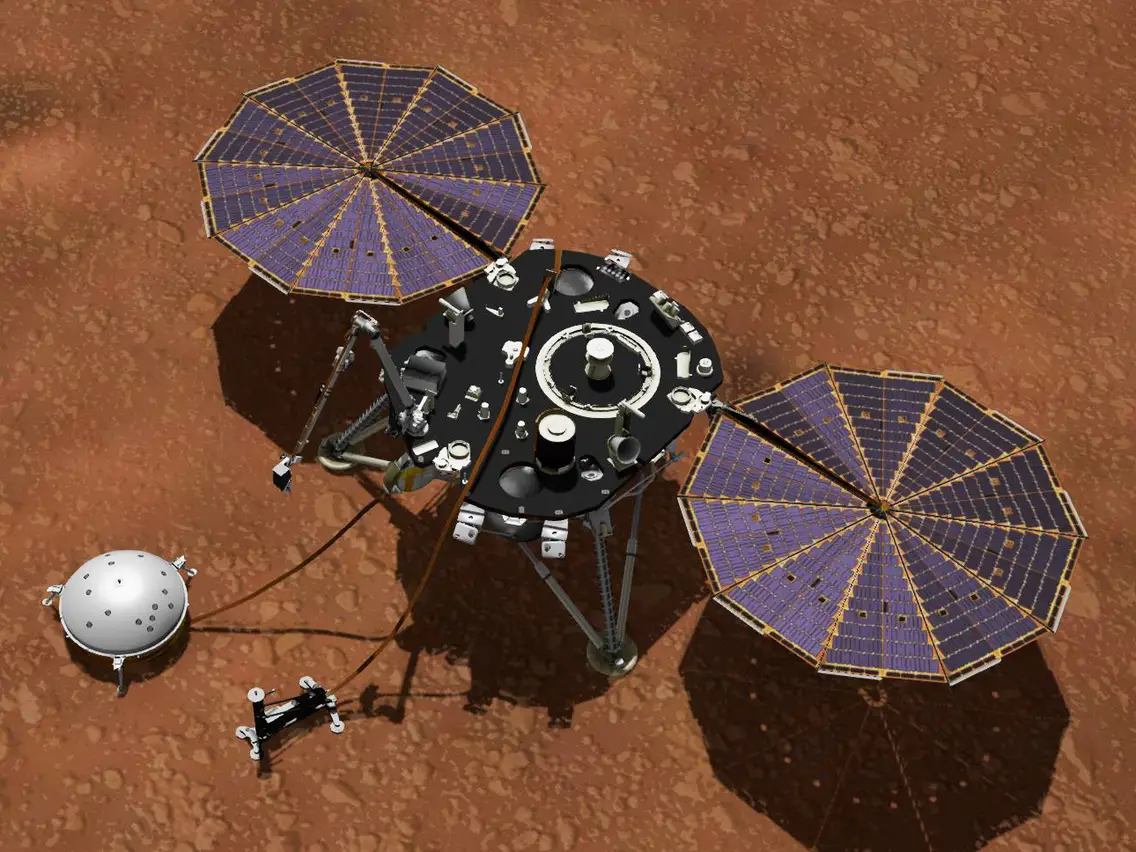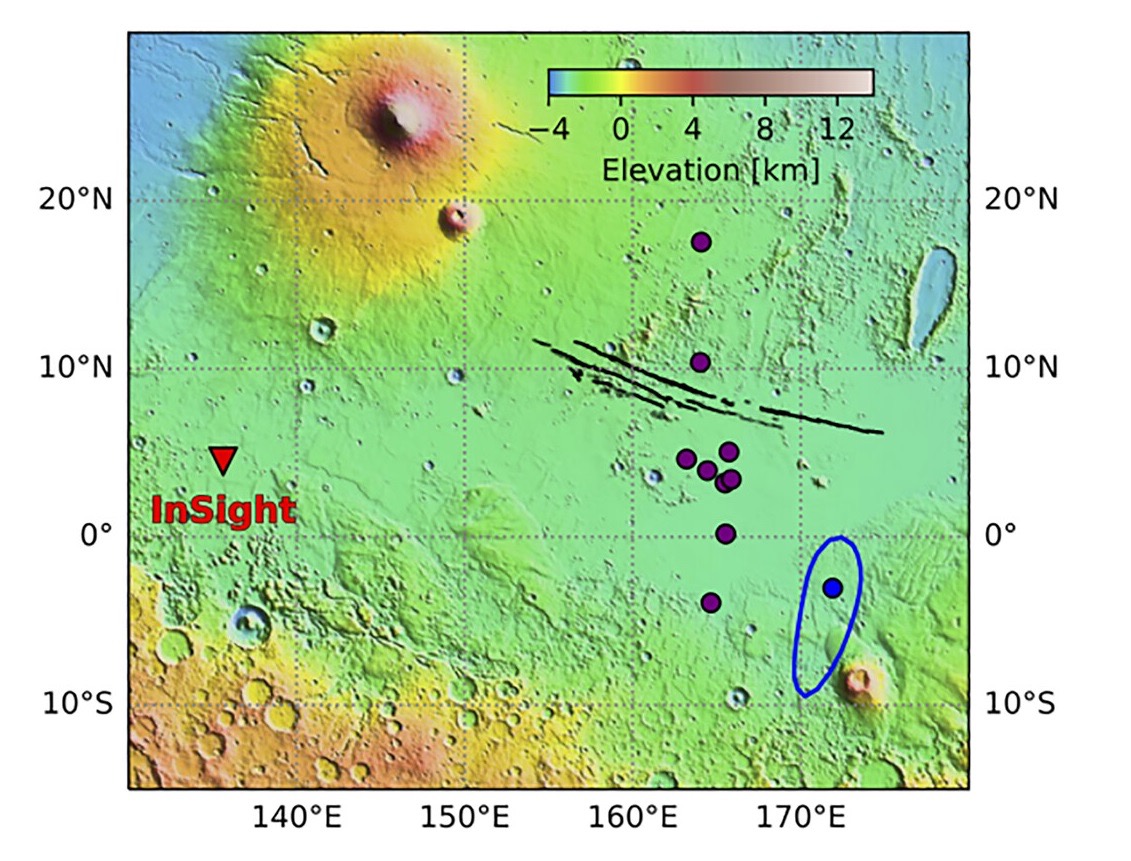A global team of researchers has determined the origin of the most significant seismic event observed on Mars, known as a Marsquake, recorded by NASA's InSight Mars lander.
After excluding the possibility of a meteor impact, they concluded that the event was likely caused by the release of stress within the planet's crust. This powerful quake occurred on May 4, 2022, at 23:23 UTC, during the 1222nd Martian day of InSight's mission. Referred to as S1222a, this quake was five times more intense than any previous event InSight had detected. It registered a magnitude of 4.7 and the tremors reverberated through Mars' crust for about six hours.
This event displayed similarities with earlier Martian seismic events, which were later determined to be the result of meteor impacts. Consequently, the scientists searched the Martian surface for any potential impact craters. To achieve this, the team utilized data from missions currently orbiting Mars, engaging in a collaborative effort involving the European Space Agency (ESA), the Chinese National Space Agency, the Indian Space Research Organisation, and the United Arab Emirates Space Agency (UAESA).
"This project represents a significant international endeavor to unravel the mystery of S1222a, and I'm deeply appreciative of all the missions that contributed," stated Benjamin Fernando, the lead researcher from the University of Oxford. "I hope this project serves as a model for fruitful international collaborations in deep space."
In the case of the most substantial meteor impacts that were detected by InSight, researchers identified craters with diameters of up to 150 meters. If S1222a had also been the result of a meteor impact, the research team anticipated discovering a crater with a diameter of 300 meters and an impact zone spanning 180 kilometers. Each participating team diligently scoured the Martian terrain for this potential crater, utilizing their respective spacecraft and comparing observations taken both before and after the occurrence of the Marsquake.
"We are committed to collaborating with scientists from across the globe to share and apply this invaluable scientific data for a deeper understanding of Mars. We take pride in contributing data from the color imagers on Tianwen-1 to support this research effort," stated Jianjun Liu of the Chinese Academy of Sciences.
 Marsquake Mystery Unveiled Through Collaborative Efforts
Marsquake Mystery Unveiled Through Collaborative Efforts
Associating a seismic event with a newly formed crater proves to be a challenging endeavor, according to the scientists. They typically identify fresh craters through the presence of a blast zone, which gradually fades but remains discernible on lower-resolution images captured shortly after an impact. Nevertheless, the presence of blast zones can vary or be obscured in certain terrains, necessitating high-resolution images to definitively rule out an impact scenario.
Another complication arises from the limited availability of high-resolution images obtained from orbiting spacecraft. These high-resolution satellite cameras possess narrow fields of view, capable of observing only small sections at a time. Consequently, certain regions may not have been imaged prior to the occurrence of an impact, making it impossible to undertake before-and-after photo comparisons in the quest for a fresh crater.
To surmount these challenges, the scientists had to rely on the combined data from all the ongoing missions orbiting Mars. "This experiment underscores the importance of maintaining a diverse range of instruments at Mars, and we are pleased to have played our part in completing the multi-instrumental and international approach of this study," commented Daniela Tirsch, Science Coordinator for the High-Resolution Stereo Camera aboard ESA's Mars Express Spacecraft.
Through the amalgamation of all the collected observations, the research team found no evidence of an impact crater that could account for the recorded seismic event. They deduced that the Marsquake must have arisen as a tectonic event within the planet's crust. "We still believe that Mars lacks active plate tectonics today, so this event likely resulted from the release of stress within Mars' crust," explained Fernando. "These stresses have built up over billions of years due to various factors, including the cooling and contraction of different regions of the planet at varying rates."
 Notably, the epicenter of the S1222a quake was located 2,200 kilometers from InSight, well outside the Cerberus Fossae region renowned for its tectonic activity. Fernando commented, "We still don't fully comprehend why some parts of the planet exhibit higher stresses than others, but findings like these drive us to delve deeper into the subject. One day, this knowledge might aid in identifying suitable habitats for human settlement on Mars and areas to be avoided."
Notably, the epicenter of the S1222a quake was located 2,200 kilometers from InSight, well outside the Cerberus Fossae region renowned for its tectonic activity. Fernando commented, "We still don't fully comprehend why some parts of the planet exhibit higher stresses than others, but findings like these drive us to delve deeper into the subject. One day, this knowledge might aid in identifying suitable habitats for human settlement on Mars and areas to be avoided."
The S1222a seismic event transpired near the end of InSight's mission, and due to power constraints resulting from dust accumulation on the solar panels, some of the lander's sensors were deactivated. As a result, the team relied solely on seismic data, without records of atmospheric pressure and wind measurements.
InSight's mission, launched on May 5, 2018, concluded in December 2022. During its operation, it detected 1,319 Marsquakes. Scientists continue to analyze InSight's data even after the mission's completion.
Dimitra Atri of New York University Abu Dhabi, who contributed data from UAESA's Hope Spacecraft, expressed enthusiasm for the collaborative efforts: "This has been a fantastic opportunity for me to collaborate with the InSight team and individuals from other major Mars missions. Truly, this is the golden age of Mars exploration!"